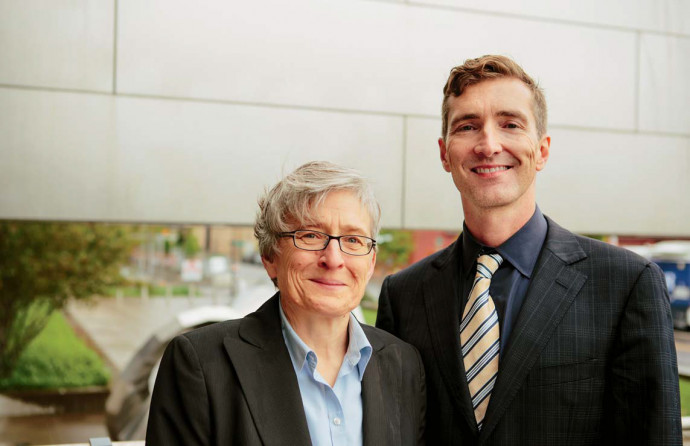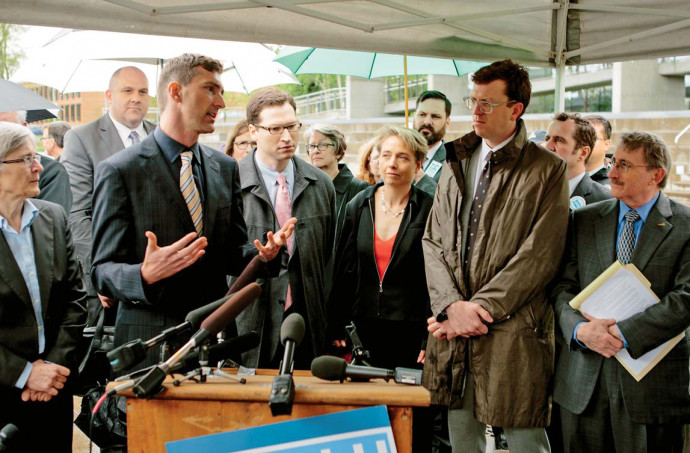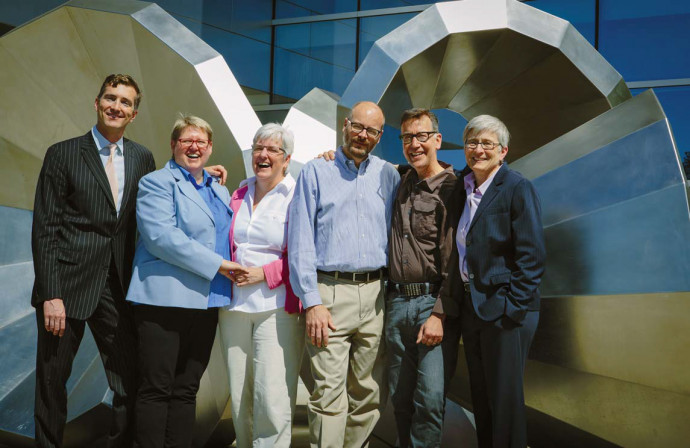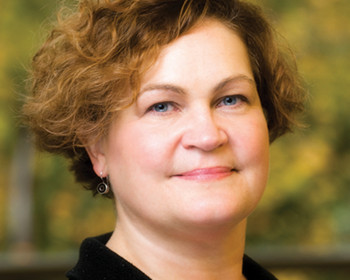All Eyes on Oregon: The Legalization of Same-Gender Marriage

By Ashley Norquist
Photos by Alicia J. Rose
On May 19, 2014, U.S. District Judge Michael J. McShane ’88 announced his ruling in Geiger v. Kitzhaber, the much-debated lawsuit filed by Lake Perriguey ’98 and Lea Ann Easton ’87. Oregon’s 10-year-old ban on gay marriage was unconstitutional. “No legitimate state purpose,” McShane wrote in his decision, “justifies the preclusion of gay and lesbian couples from civil marriage.”
With that, Oregon joined the growing number of states allowing same-gender marriage. Yet many people have asked why a state with such a progressive reputation was not at the forefront of this movement. And why did it have a ban to begin with?
A Brief History of Same-Gender Marriage in Oregon
In January of 2004 Basic Rights Oregon, an advocacy group dedicated to equal rights for the state’s lesbian, gay, bisexual, and transgender population, posed this question to several Multnomah County commissioners: What would happen if a gay couple were to request a marriage license? After deliberating the issue—and hearing from a large number of Basic Rights Oregon members—Multnomah County began offering same-sex marriage licenses. Benton County followed suit.
The backlash was prompt. Many slammed the commissioners for setting key public policy without wide public participation. It wasn’t long before the Defense of Marriage Coalition, an organization devoted to defining marriage as the union between one man and one woman, began advocating for a constitutional amendment banning same-gender marriage in Oregon.
Oregon Ballot Measure 36 was brought to voters in 2004 by initiative petition. The measure, which featured language approved by the Defense of Marriage Coalition, passed with 57 percent of the vote. In addition to nullifying the approximately 3,000 same-gender marriage licenses issued by Multnomah County, opponents say that it had a chilling effect on attempts to advocate for equal rights in the courts.
Matters remained at a legal standstill for several years. The 2007 Oregon Family Fairness Act gave same-gender couples the right to register domestic partnerships, but these partnerships did not entail many of the rights marriage licenses conferred on straight couples. It wasn’t until late 2012—and only after Maine, Minnesota, Washington, and Maryland had approved same-gender marriage—that polls registered a significant shift in support for same-gender marriage in Oregon
Clearly, though, the tide was turning. The U.S. v. Windsor decision had deemed the Defense of Marriage Act (DOMA) unconstitutional. The U.S. Supreme Court had ruled that intervenors did not have standing to appeal, allowing the trial court’s decision in Perry v. Schwartzenegger to stand. This, in turn, had invalidated California’s Proposition 8, which once banned same-gender marriage. Portland lawyer Lake Perriguey decided it was time to act.
To Sue or Not to Sue
Lake Perriguey has advocated for the rights of the LGBTQ community for years. He was inspired to become a part of the legal system when he was arrested in Austin, Texas, while protesting that state’s sodomy laws and had a chance meeting with the lawyer representing the protesters. (These laws were eventually overturned by the U.S. Supreme Court in Lawrence v. Texas, a case Perriguey would cite in his legal briefs and during oral argument in the Geiger case.) In the run-up to the vote on Measure 36, he canvassed door to door with Basic Rights Oregon.
“I had been told it wasn’t the right time ever since I got out of law school. But after Windsor and Perry, I realized I didn’t need to ask permission anymore.”Lake Perriguey ’98
After the Windsor decision, Perriguey saw that key political figures in Oregon were ready to put the issue of same-sex marriage back on the ballot. But the election was still 19 months away and the strategy would cost millions of dollars. On his own, Perriguey began searching for a set of plaintiffs and told Attorney General Ellen Rosenblum he planned on suing her and the governor. His aim was to “put the marriage apartheid issue to rest” in Oregon without engendering huge advertising expenses and subjecting the rights of a minority to the whim of a majority.
Perriguey’s plan was discouraged by Basic Rights Oregon and its sister organization Oregon United for Marriage. The two progressive groups had national money and support for a ballot measure to overturn the constitutional and statutory limitations to marriage equality. They were concerned that a lawsuit might sour public opinion. Perriguey, however, remained confident. He believed his suit would provide a faster and much less expensive route to marriage equality in the state. And he was tired of waiting. “I had been told it wasn’t the right time ever since I got out of law school,” said Perriguey. “But after Windsor and Perry, I realized I didn’t need to ask permission anymore.”
The day after the filing, the Office of the Attorney General directed all state agencies to recognize same-sex marriages that were legally performed in jurisdictions outside of Oregon.
He enlisted the help of fellow Lewis & Clark alumna Lea Ann Easton, who had built a career advancing cases within Native American communities and had experience in federal court. Perriguey invited her to be cocounsel. “Lea Ann clearly understood the issues and was equally weary of the people who were telling us it wasn’t the right time,” Perriguey said. “She recognized that, with the decisions in the Windsor and Perry cases, there was a fairly clear roadmap to marriage equality in Oregon that did not require voting on people’s civil rights.”
On October 15, 2013, with Perriguey as lead attorney, Deanna Geiger, Janine Nelson, William Griesar, and Robert Duehmig filed Geiger v. Kitzhaber against Governor John Kitzhaber, the attorney general, and other state actors. Geiger and Nelson wanted a marriage license and full legal rights. Griesar and Duehmig sought full legal recognition of their existing marriage, which had been performed in Canada. The attorneys kept the filing relatively quiet, so as not to alert opposition groups. Although he had chosen to disregard the group’s urgings, Perriguey respected Basic Rights Oregon’s efforts and wanted to avoid confusing or swaying voters, in case a same-gender marriage measure appeared on the next ballot.

The day after the filing, the Office of the Attorney General directed all state agencies to recognize same-sex marriages that were legally performed in jurisdictions outside of Oregon. Perriguey was happily surprised. The action convinced many that he was on the right track—including Basic Rights Oregon and Oregon ACLU, which soon after publicly expressed its support for a legal strategy. In fact, the organization urged Perriguey to combine his suit with one they were putting together, Rummell and West v. Kitzhaber. (Perriguey’s clients declined, fearing that the resulting delay would create an opportunity for opposition to build.)
Rosenblum informed the public that she would not be defending the state in the case. “It is now clear,” she said in her statement, “that there is no rational basis for Oregon to refuse to honor the commitments made by same-sex couples in the same way it honors the commitments of opposite-sex couples.”
In February of this year, Rosenblum informed the public that she would not be defending the state in the case. “It is now clear,” she said in her statement, “that there is no rational basis for Oregon to refuse to honor the commitments made by same-sex couples in the same way it honors the commitments of opposite-sex couples.” People around the country took note. Before celebrations could begin in earnest, however, the National Organization for Marriage stepped forward. It wanted to defend the ban in place of the attorney general.
“Certain Rights Should Be Shielded From the Barking Crowds”
U.S. District Judge Michael J. McShane has led a life marked by service. Fresh out of college, he moved to Portland to help homeless parolees access essential resources, such as housing and food. His longtime commitment to at-risk youth and willingness to mentor young attorneys are well documented and respected. According to Multnomah County Circuit Court Judge Eric Bergstrom ’90, a former DA, McShane has a reputation for fairness that stretches back to McShane’s earliest days as a lawyer.
McShane, who was raised in a conservative Catholic family and once served with the Jesuit Volunteer Corps, is also Oregon’s first openly gay federal judge.
In his first ruling concerning Geiger v. Kitzhaber, McShane denied the National Organization for Marriage’s request for a role in the proceedings. The group immediately filed with the Ninth U.S. Circuit Court of Appeals for an emergency stay, hoping to delay the lawsuit. Perriguey and his team, who had been watching the organization’s tactics in other states, were prepared with a response. Hours before McShane announced his ruling in Geiger v. Kitzhaber, the Ninth U.S. Circuit Court of Appeals refused the socially conservative group’s request.

It was clear in the language of his decision that McShane sought neither to minimize his personal experiences nor to allow them to dictate his conclusions. He noted that Oregon’s ban and related laws didn’t meet even the lowest standards for constitutionality—as he put it, they “cannot withstand the most relaxed level of scrutiny”—and outlined each reason why. Chief among these, he found, was that the Equal Protection Clause requires that the voice of the minority not be diminished by the popular vote of the majority.
“It is at times difficult to see past the shrillness of the debate,” he wrote in his opinion. “At the core of the Equal Protection Clause, however, there exists a foundational belief that certain rights should be shielded from the barking crowds.”
“I am aware that a large number of Oregonians, perhaps even the majority, have religious or moral objections to expanding the definition of civil marriage to gay and lesbian families,” he wrote. “Generations of Americans, my own included, were raised in a world in which homosexuality was believed to be a moral perversion, a mental disorder, or a mortal sin. …It is not surprising then that many of us raised with such a world view would wish to protect our beliefs and our families by turning to the ballot box to enshrine in law those traditions we have come to value.”
“I believe that if we can look for a moment past gender and sexuality, we can see in these plaintiffs nothing more or less than our own families. Families who we would expect our Constitution to protect, if not exalt, in equal measure.”Judge Michael J. McShane ’88
But, McShane wrote, “I believe that if we can look for a moment past gender and sexuality, we can see in these plaintiffs nothing more or less than our own families. Families who we would expect our Constitution to protect, if not exalt, in equal measure.”
McShane closed the opinion by acknowledging “many suggest we are going down a slippery slope that will have no moral boundaries. To those who truly harbor such fears, I can only say this: Let us look less to the sky to see what might fall; rather, let us look to each other…and rise.”
What Has Changed?
“I’ve never actually lived in a state where I was equal to straight people under the law, so this is a new experience,” said Perriguey. “It is surprisingly quite profound.”
Same-gender married couples are now granted the rights enjoyed by other married couples. Among other things, this means they cannot be denied service by for-profit businesses or spousal benefits by employers.
Perriguey also believes that the media coverage of this case and its outcome has encouraged better communication among young LBGTQ people, their families, and the larger community. “Having these matters on the front page of the newspaper and on TV certainly brings these issues to the breakfast table,” he said. “When I was young, when people said the word gay it was often in a whisper.”
Oregon’s same-gender couples had to wait a long time for their rights to be acknowledged and affirmed by a federal court. Now—finally, many will say—these couples can live without fear of legal discrimination.
More Advocate Magazine Stories
email jasbury@lclark.edu
voice 503-768-6605
Judy Asbury, Assistant Dean, Communications and External Relations
Advocate Magazine
Lewis & Clark Law School
10101 S. Terwilliger Boulevard MSC 51
Portland OR 97219

